色素炭黑说明书MSDS
炭黑MSDS

blacks. The foregoing are registered trade names of Cabot Corporation, and denote
physical differences in carbon black grades.
Manufacturer抯 Product Code: Not applicable.
MSDS
Page 2 of 6
MATERIAL SAFETY DATA SHEET
Swallowed: None expected.
Eye: Mechanical irritant with no adverse effects.
Skin: None expected but may dry skin with prolonged exposures. Use of quality barrier cream can prevent skin dryness.
Inhaled: None expected. Temporary discomfort to the upper respiratory tract may occur due to inhalation of dust concentrations above the OEL.
Human Studies: Epidemiological studies of workers in the carbon black producing industries of North America and Western Europe show no evidence of clinically significant, adverse health effects due to occupational exposure to carbon black.
炭黑MSDS of carbon black

SECTION 2 COMPOSITION/ INFORMATION ON INGREDIENTS COMPONENT CAS NUMBER AMOUNT CARBON BLACK 1333-86-4 100.00 % weight Occupational Exposure Limits: Component Limit TWA STEL Ceiling Notation CARBON BLACK ACGIH_TLV 3.5 mg/m3 NA NA NA CARBON BLACK OSHA_PEL 3.5 mg/m3 NA NA NA
SECTION 3 HAZARDS IDENTIFICATION
EMERGENCY OVERVIEW
Odorless black powder. - MAY CAUSE RESPIRATORY TRACT IRRITATION IF INHALED IMMEDIATE HEALTH EFFECTS: Eye: Not expected to cause prolonged or significant eye irritation. Skin: Not expected to be harmful to internal organs if absorbed through the skin. Contact with the skin is not expected to cause prolonged or significant irritation. Ingestion: Not expected to be harmful if swallowed. Inhalation: The dust from this material may cause respiratory irritation. Symptoms of respiratory irritation may include coughing and difficulty breathing. DELAYED OR OTHER HEALTH EFFECTS: Cancer: May cause cancer in laboratory animals, but the available information is inadequate to determine if this material can cause cancer in humans. See Section 11 for additional information. Risk depends on duration and level of exposure
炭黑msds.doc

材料安全数据表1.化学品及企业信息化学品中文名称炭黑编码 111俗名/商品名炭黑生效日期化学品英文名称 calcium hypochlorite企业名称上海卡博特化工有限公司企业应急电话地址邮编国家应急电话传真电子邮件地址2.成分 / 组成信息□混合物主要成分■纯品危害成分浓度CAS No. 1333-86-43.危险性概述危险性类别不是危险品侵入途径呼吸,眼睛接触,皮肤接触。
吸入刺激鼻腔、嘴、喉;接触刺激皮肤和眼睛;长期暴露,会损伤皮肤和指甲,造成暂时或永健康危害久性损伤,伤害肺和呼吸道,并对心脏产生不良影响。
慢性接触引起咳嗽、咳痰、烦燥、胸痛、头痛、肺损害、气管炎、皮疹。
健康危害 ( 蓝色 ) :1环境危害燃烧危险4.急救措施皮肤接触用肥皂和水清洗,如果皮肤发红,水肿,发痒或灼伤。
就医。
眼睛接触用大量的水立即冲洗眼睛15 分钟。
如果发红,水肿,发痒,灼伤或视觉模糊就医。
吸入不必催吐。
如果清醒的,饮几杯水。
不要通过嘴给不清醒的人任何东西。
食入5.消防措施燃烧会产生刺激烟雾。
本品不溶于水并浮于水。
如可能,除去漂浮物,原因是漂浮物构成流动危险特性火灾的危险。
有害燃烧物一氧化碳,二氧化碳硫的氧化物灭火方法使用与所在地环境情况相适合的灭火方法。
如果用水,建议用喷雾水。
不能用强力的直流水,及灭火剂直流水会分散火源。
注意事项粉尘爆炸的粉尘与空气混合可能形成爆炸混合物,禁止使用掸,拂或者高压空气吹扫粉尘,避免形成粉尘风险团。
6.泄露应急处理应急处理须穿戴防护用具进入现场;排除一切火情隐患;用简便、安全的方法收集粉尘于密闭的容器内,待处理。
环境信息:应急计划和社区知情权法:款313 表 R,最低应报告浓度0 . 1%。
消除方法7.操作处置与储存操作注意事项储存避免接触禁忌物,严禁烟火。
须贴“自燃”标签,严禁航空、铁路运输。
ERG 指南: 133 ERG 注意事项指南分类:易燃固体8.接触控制 / 个体防护最高容许浓度3 3监测方法4mg/mTWA 8mg/mSTEL工程控制保证正确的通风,控制暴露在职业卫生允许值以下。
德固赛炭黑介绍

不同供应形式碳黑的差异
粉状碳黑 珠状碳黑-干法
优点
较容易分散
较少粉尘 倾注密度高 好的流动性
缺点 粉尘较大 倾注密度低 差的流动性 较难分散
Page | 13
议程
色素炭黑一般Байду номын сангаас绍 色素碳黑的生产工艺 色素碳黑的特性对涂料的影响 其它影响碳黑性能的因素 色素碳黑的推荐
Page | 14
色素碳黑特性对涂料的影响
碳黑的分散工艺
1. 研磨浆 预分散
➢ 把碳黑润湿于树脂中
研磨 ➢ 分散和稳定碳黑 ➢ 需要高剪切力的研磨设备把碳黑的附集体分散. 例如 沙磨, 珠磨,
球磨
2. 调漆 加入其余的树脂,溶剂和助剂 (只需搅拌)
Page | 44
用于涂料工业的氧化气黑
氧化气黑
FW 200, FW 2
高色素气黑,最高黑度和蓝相
较高 蓝相
较强 红相 较困难 较高 较低
Page | 17
原生粒径对黑度的影响
(醇酸氨基烤漆, 5% 碳黑基于树脂固含)
Page | 18
原生粒径对着色力的影响
粒径, nm
120
110
101
100
相对着色力, %
95nm
80
65
60
50nm
40
25nm
30
13nm
20
0 Colour Black Special Black 4 Special Black 100 Lamp Black 101
平均原生粒径
表面化学 结构
Page | 15
不同颜料的平均粒径大小 比较
酞氰蓝 钛白粉
LB 101 FW 200
色素炭黑colrblack在油墨
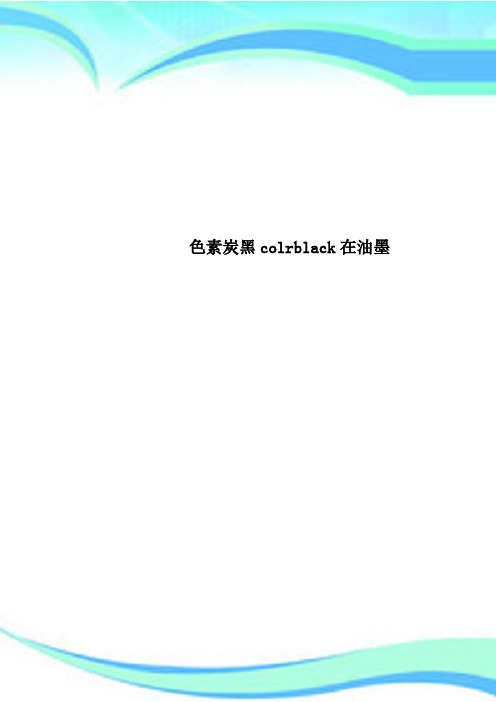
色素炭黑colrblack在油墨————————————————————————————————作者:————————————————————————————————日期:色素炭黑color black 在油墨、油漆、涂料、塑料等制品中作着色颜料用的炭黑。
按着色强度(或黑度)和粒子大小一般分为高色素炭黑、中色素炭黑、普通色素炭黑和低色素炭黑四种。
主要是油炉法生产和槽法生产。
目录1用途2种类3特性4应用5制备6选购7原理8技术参数1用途编辑色素炭黑一般都能较好的给塑料着色,可根据着色特性或物化性能选用色素炭黑,着色用炭黑的品种的选择基本上都是随成品必须达到的黑度而定。
用极细的色素炭黑可以完成黑度要求特别高的着色;PE垃圾袋,塑料袋,电缆材料之类产品只需中等水平黑度,可以用比表面积较低,结构较高的炭黑品种;塑料调色时,炭黑称量和配料时出现的微小误差,均会导致明显的色差,因此,宜采用粒径较大,着色力较差的低色素炭黑,这样炭黑用量可以稍大,称量误差相对小些,并有分散性较好、价格较低的优点。
对于灰色塑料,采用细粒色素炭黑往往呈现棕相灰色,而采用粗粒子色素炭黑可产生蓝相灰色。
2种类编辑因为色素炭黑作为一种黑色颜料,在市场上有着较为广泛的应用,现将其用途详细明细;密封胶类:汽车密封胶专用、建筑密封胶专用、船舶密封胶专用,集装箱密封胶,工业密封胶胶专用,防水密封胶用,热熔胶用,中空玻璃密封胶用,色素碳黑中空玻璃丁基胶用,中性防霉硅酮密封胶用,铜密封胶用,聚氨脂密封胶用,中性玻璃密封胶用,密封胶条用,酸性硅酮密封胶用,丁基密封胶用。
色浆类:黑合成革色浆用,印花色浆用,水性色浆用,造纸色色素碳黑(2张)浆用,苹果袋纸用,PVC色浆专用,PU色浆用,油性色浆专用。
色母类:色素碳黑(鞋材EVA发泡用) ,色素碳黑无卤电缆料专用,(塑料发泡专用)色素炭黑,色素碳黑吹膜色母用,色素碳黑塑料色母用,色素碳黑PVC电缆料用,色素碳黑PVC 胶粒用,色素碳黑涤纶母粒用,色素碳黑高光泽蓝相色母用,色素碳黑化纤色母用,色素碳黑短纤色母用,色素碳黑压延膜用,色素碳黑PE电缆料用。
德固赛炭黑介绍
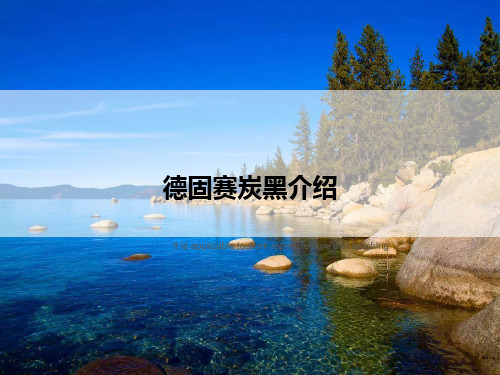
60
50
24 m
40
30 20
10 0 FW 200
12 m 24 m
FW 2
12 m 24 m
SS 6
12 m 24 m
USA I
12 m 24 m
12 m
12 m 24 m
24 m
Japan I
USA III
USA II
光泽的损失--- 42 天ADF测试
(5% pigment black as against Lioptal A 453)
议程
色素炭黑一般介绍 色素碳黑的生产工艺 色素碳黑的特性对涂料的影响 其它影响碳黑性能的因素 色素碳黑的推荐
碳黑的生产工艺---气黑
• 德固赛在 1935独创的生产工艺 • 碳氢化合物的不完全燃烧 • 敞开的反应设备, 表面氧化程度高 4-6% • 平均原生粒径在 10-30 nm
碳黑的生产工艺---炉黑
SB 6
75.3
86.8
73.9
润湿剂对黑度和色相的影响
FW 285, 聚氨酯分散液
My
350 300 250 200 150 100
50 0
*Hydropalat
dM (x10) My
影响碳黑稳定性的因素
碳黑特性
原生粒径 表面处理
结构
因素
树脂体系
溶剂和助剂
分散
润湿性 极性 溶剂型 水性
分散剂 溶剂
黑度值 My
400 300
200
Black
100
0
0,01
0,1
1
光反射率%
Grey
White
10
100
黑度值My 和色相值dM的定义
炭黑 MSDS

1.化学品及企业信息
化学品中文名称
炭黑
编 码
111
俗名/商品名
炭黑
生效日期
化学品英文名称
calcium hypochlorite
企 业 名 称
上海卡博特化工有限公司
企业应急电话
地 址
邮 编
国家应急电话
传真
电子邮件地址
2.成分/组成信息
主要成分
■纯品 □混合物
危害成分
浓 度
CASNo.
1333-86-4
填表时间
2010-07-27
修改说明
重新编码
有害燃烧物
一氧化碳,二氧化碳硫的氧化物
灭火方法
及灭火剂
注意事项
使用与所在地环境情况相适合的灭火方法。如果用水,建议用喷雾水。不能用强力的直流水,直流水会分散火源。
粉尘爆炸的风险
粉尘与空气混合可能形成爆炸混合物,禁止使用掸,拂或者高压空气吹扫粉尘,避免形成粉尘团。
6.泄露应急处理
应急处理
须穿戴防护用具进入现场;排除一切火情隐患;用简便、安全的方法收集粉尘于密闭的容器内,待处理。 环境信息: 应急计划和社区知情权法:款313表R,最低应报告浓度 0.1%。
呼吸系统防护
如果工作地通风不良,需配备合适的呼吸保护设备。
眼睛防护
使用眼部和面部防护:有两侧防护的安全眼镜。
身体防护
穿着合适的防护服,每天清洗服装。污染的工作服不允许带出厂。
手防护
戴手套防止手弄脏,反复接触可能造成皮肤干燥或开裂。在处理本产品前可用油膏护手。
其他防护
用良好工业卫生及安全实践相一致的处理/操作方法进行日常的操作。附近可设置京戏急洗眼和冲洗设备。
炭黑MSDS通用安全技术说明书

化学品安全技术说明书1、企业资质认证产品名称:N炭黑别名:炭黑,炉法炭黑材料应用:各种工业产品供应商:炭黑有限公司地址:中国68号联系电话: 666 传真: 8882、炭黑的组成成分3、危险性概述危害显示:本品为非危险物品主要接触途径:吸入,眼睛接触,皮肤接触。
潜在的健康影响:眼睛接触:可能引起机械刺激。
但是不会永久的伤害眼膜。
对于平常的工业或商业接触有较低的危害。
皮肤接触:无已知的不良反应。
吸入:粉尘可能刺激呼吸道。
应对机器设备和能够产生灰尘的地方提供适当的排气通风。
另请参阅第8部分。
食入:正常使用下不会出现已知的健康损伤。
对于平常的工业或商业接触只有较低的危害。
致癌影响:国际癌症研究机构列出的物品。
另请参阅第9部分。
主要影响器官:肺。
暴露恶化的疾病:哮喘,呼吸障碍潜在的环境影响:不需要特别的环境预防措施。
不溶解于水。
另请参阅第12部分。
4、急救措施皮肤接触:应用肥皂和水彻底清洗。
若症状加重,请就医。
眼睛接触:应立即用大量的水冲洗眼睛15分钟。
若症状加重,请就医。
吸入:如果咳嗽,呼吸急促或者发生其他呼吸问题,请移到其他地方呼吸新鲜空气。
若症状无好转,请就医。
如果有必要的话,请通过标准的急救措施来恢复正常呼吸。
食入:不要催吐,如清醒,给予几杯水,千万不要给休克的人通过口腔喂任何东西。
医生提示:请根据症状处理。
5、消防措施灭火器:应使用泡沫,二氧化碳,干粉或者水喷雾。
如果已经使用过水,推荐使用水雾。
不要使用强直流水,因为它可能溅射扩散火苗。
消防员的特殊防护装备:要穿戴合适的防护装备。
发生火灾时,应佩带独立的呼吸设备。
具体危害:炭黑燃烧时可能不明显,除非搅拌时出现火花。
对已经着火的炭黑,我们应该严密地观察至少48小时以确保无隐燃存在。
燃烧会产生刺激性的烟气。
该产品不能溶解的,并且漂浮在水上。
如果可能,设法控制悬浮物质。
该物质会产生火灾隐患,因为它漂浮在水上。
分解或燃烧产生的危害物:一氧化碳,二氧化碳,硫的氧化物,分解的有机产物。
色素炭黑是什么
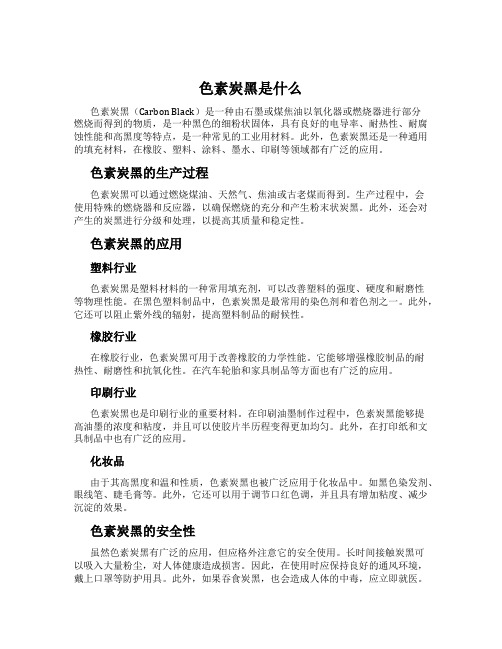
色素炭黑是什么色素炭黑(Carbon Black)是一种由石墨或煤焦油以氧化器或燃烧器进行部分燃烧而得到的物质,是一种黑色的细粉状固体,具有良好的电导率、耐热性、耐腐蚀性能和高黑度等特点,是一种常见的工业用材料。
此外,色素炭黑还是一种通用的填充材料,在橡胶、塑料、涂料、墨水、印刷等领域都有广泛的应用。
色素炭黑的生产过程色素炭黑可以通过燃烧煤油、天然气、焦油或古老煤而得到。
生产过程中,会使用特殊的燃烧器和反应器,以确保燃烧的充分和产生粉末状炭黑。
此外,还会对产生的炭黑进行分级和处理,以提高其质量和稳定性。
色素炭黑的应用塑料行业色素炭黑是塑料材料的一种常用填充剂,可以改善塑料的强度、硬度和耐磨性等物理性能。
在黑色塑料制品中,色素炭黑是最常用的染色剂和着色剂之一。
此外,它还可以阻止紫外线的辐射,提高塑料制品的耐候性。
橡胶行业在橡胶行业,色素炭黑可用于改善橡胶的力学性能。
它能够增强橡胶制品的耐热性、耐磨性和抗氧化性。
在汽车轮胎和家具制品等方面也有广泛的应用。
印刷行业色素炭黑也是印刷行业的重要材料。
在印刷油墨制作过程中,色素炭黑能够提高油墨的浓度和粘度,并且可以使胶片半历程变得更加均匀。
此外,在打印纸和文具制品中也有广泛的应用。
化妆品由于其高黑度和温和性质,色素炭黑也被广泛应用于化妆品中。
如黑色染发剂、眼线笔、睫毛膏等。
此外,它还可以用于调节口红色调,并且具有增加粘度、减少沉淀的效果。
色素炭黑的安全性虽然色素炭黑有广泛的应用,但应格外注意它的安全使用。
长时间接触炭黑可以吸入大量粉尘,对人体健康造成损害。
因此,在使用时应保持良好的通风环境,戴上口罩等防护用具。
此外,如果吞食炭黑,也会造成人体的中毒,应立即就医。
总之,色素炭黑是一种广泛应用的工业材料,具有良好的电导率、耐热性、耐腐蚀性能和高黑度等特点。
不过,在使用时也要格外注意它的安全性,防止对人体和环境造成损害。
卡博特炭黑产品详细资料

卡博特炭⿊产品详细资料卡博特炭⿊炭⿊种类牌号⽤途和特性导电和抗紫外光类BP2000吸油值:330M2/g,粒径:12nm,着⾊⼒:164塑料、涂料:在低炭⿊填充情况下也能保持物理性能的⾼导电性炭⿊。
VXC72吸油值:174M2/g,粒径:30nm,着⾊⼒:87塑料、涂料:⽤于导电和防静电的⼀种⼯业标准。
605VXC305BP3200塑料:⾼质量的极纯碳⿊,分散性好、⾼着⾊⼒、耐紫外光和抗静电等特性。
⾼⾊调类S90B涂料:在溶剂涂料中具有极⾼的⿊度。
M1300涂料:在溶剂和⽔性涂料中良好的⿊度和⾼的⿊度。
中⾊调类900塑料、涂料:塑料、磁漆和喷漆⽤的中⾼⾊素。
适⽤于⽪⾰⾊浆,⿊度卓越。
M88塑料、涂料:具有良好分散性的中级⿊度。
800ML涂料、油墨:极佳分散性和稳定性,⿊度好导电性最低,适⽤中⾼档⼯业涂料、UV油墨V9A32塑料、涂料:具有⾼着⾊⼒、良好的颜⾊。
普通⾊调M570/E570塑料、涂料、油墨:具有良好⿊度、着⾊⼒。
H塑料、油墨、涂料:具有⾼着⾊⼒和低黏度。
油墨、涂料:具有良好的流动性、分散性和光泽的油墨。
⽤于涂料中有好的稳定性和着⾊⼒。
R660R40R330R25油墨:在⾼油墨填充情况下能保持低粘度、极佳的光泽和强蓝相。
R99R油墨:油墨⽤的⼀般碳⿊。
提供好的分散性和蓝相,稳定性⾼。
M430涂料、油墨:良好的⿊度,易分散。
47⽔墨:易分散、较强着⾊⼒、较纯净。
DL430涂料、油墨、⾊浆:具有易分散、低杂质、⾊泽均匀。
电线电缆料M717良好的⿊度,易分散,低吸油值,吸附性好,蓝⾊相。
电缆半导电屏蔽料可选⽤导电炭⿊:VXC72VXC605VXC305BP-2BP-7型号140V58元种类/⽤途⾊素碳⿊品牌德固赛应⽤推荐油墨CAS13-86-4执⾏标准ROHS德固赛炭⿊:普通⾊素槽法炭⿊:特⿊4,特⿊4a,printexu,printexv,printex140u,printex140vprintexu和pintexv、140v中等⿊度的主⾊和调⾊碳⿊,⽤于涂料和油墨,印刷和复印油墨、复写纸、打印⾊带、塑料和合成纤维。
MSDS碳黑

英文根据上海卡博特的需要更正Date of Issue: 22 November, 1996Shanghai Cabot Chemical Co., Ltd.MATERIAL SAFETY DATA SHEETSTATEMENT OF HAZARDOUS NATURECurrently under review.COMPANY DETAILS:Company: Shanghai Cabot Chemical Co., Ltd.Address: 15 Shuang Bai Road, Shanghai, China201108Telephone: (86)21-64345809Facsimile: (86)21-64345532IDENTIFICATIONProduct Name: Carbon black.Other Names: ACARB?, STERLING?, TINTACARB?, BLACK PEARLS? VULCAN?, REGAL?, ELFTEX?, MOGUL?, MONARCH?, IRX?, CRX? and CSX? carbon blacks. The foregoing are registered trade names of Cabot Corporation, and denote physical differences in carbon black grades.Manufacturer抯 Product Code: Not applicable.UN Number: None allocated.Dangerous Goods Class and Subsidiary Risk: No listed in<Dangerous Goods list GB 12268-90>Hazchem Code: No listed in<Dangerous Goods list GB 12268-90>Poisons Schedule Number: No listed in<Dangerous Goods list GB 12268-90>Use: Used as a filler, reinforcing agent, pigment, electrical conducting or chemical reducing agent, in rubbers, plastics, inks, copy machine toners, paints and batteries.PHYSICAL DESCRIPTION / PROPERTIES:Appearance: Odourless, amorphous black inert solids, pellets or powder.Boiling Point / Melting Point: Not applicable.Vapour Pressure: Not applicable.Specific Gravity: 1.7 to 1.9Flashpoint: Not applicable (powder substance)Flammability Limits: Not applicable (combustible solid).Solubility in Water: Insoluble.Recommended Occupational Exposure Limit: 8.0 mg / m3 (Black powder sanitationstandard in the air of workshopGB-10330-89)Reference to China National StandardOTHER PROPERTIES:Ingredients:Chemical Name: Carbon / CCAS Number: 1333-86-4Proportion: 100%HEALTH HAZARD INFORMATIONHEALTH EFFECTS:Acute: None known other than possible temporary discomfort due to inhalation of high dust concentrations and possible mechanical eye irritation.Chronic:NOTE: In April 1996, IARC (International Agency for Research on Cancer) issued a Monograph that changed its evaluation of carbon black from a Class 3 substance - that is, a substance with inadequate information to determine if it is carcinogenic to a Class 2b substance - that is, a substance that is a possible human carcinogen. It is now classified in Class 2b with other well known items such as coffee, saccharin and petrol.IARC Classifications:Class 1 substances are known human carcinogens,Class 2a substances are probable human carcinogens,Class 2b substances are possible human carcinogens,Class 3 substances have insufficient data to determine whether they might be human carcinogens,Class 4 substances are probably not human carcinogens.Swallowed: None expected.Eye: Mechanical irritant with no adverse effects.Skin: None expected but may dry skin with prolonged exposures. Use of quality barrier cream can prevent skin dryness.Inhaled: None expected. Temporary discomfort to the upper respiratory tract may occur due to inhalation of dust concentrations above the OEL.Human Studies: Epidemiological studies of workers in the carbon black producing industries of North America and Western Europe show no evidence of clinically significant, adverse health effects due to occupational exposure to carbon black.Early studies in the former USSR and Eastern Europe report respiratory diseases among workers exposed to carbon black, including bronchitis, pneumoconiosis, emphysema and rhinitis. Such studies areof questionable validity, due to inadequate study design and methodology, lack of appropriate controls for cigarette smoking and other confounding factors, such as concurrent exposures to carbon monoxide, coal oil and petroleum vapours. Moreover, review of these studies indicates that concentrations of carbon black were greater than current occupational exposure standards. In its Monograph Volume 65, issued in April 1996, the International Agency for Research on Cancer (IARC) re-evaluated carbon black and concluded that 搕here is inadequate evidence in humans for the carcinogenicity of carbon black”.。
炭黑说明书

色素炭黑的安全技术说明书(MSDS)第一部分:化学品名称和公司中文名称1:色素炭黑英文名称1:color pigment carbonCAS No.:1333-86-4分子式:C 分子量:12第二部分:成分/组成信息主要成分:碳(C)元素含量(Wt%)≥93%;含氧基团含量(Wt%)≤7%。
有害物成分:多环芳烃(PAH)(CAS No.¡ )含量(Wt%)≤0.001%砷(As)(CAS No.7440-38-2)含量(Wt%)≤0.0001%镉(Cd)(CAS No.7440-43-9)含量(Wt%)≤0.00001%汞(Hg)(CAS No.7439-97-6)含量(Wt%)≤0.0001%铅(Pb)(CAS No.7439-92-1)含量(Wt%)≤0.0001%铬(Cr)(CAS No.7440-47-3)含量(Wt%)≤0.001%(资讯来源:昊客云台,上面更多产品知识,行业资讯热点)第三部分:危险性概述危险性类别:未列入侵入途径:呼吸道吸入、眼睛、皮肤健康危害:长期大量地由呼吸道吸入炭黑粉尘,可能最终造成对肺部的损伤。
目前,没有明确的医学报道证明炭黑会引起癌变的结果。
但可以列入如人类的可能致癌的物质。
对眼睛的损伤主要症状是异物刺激感、流泪。
对皮肤主要是皮肤的弄脏和刺激环境危害:炭黑的外泄暴露,除了会弄脏周围环境外没有发现会对环境造成严重的影响或损害。
燃爆危险:在本品工作场所若形成纯炭黑的粉尘环境,可能造成粉尘爆炸。
本品不是易燃物,一般不会被点燃,若较长时间地处于300℃以上则可能会无明火地缓慢燃烧,同时释出一氧化碳、二氧化碳或极少量的含氮、硫氧化物。
第四部分:急救措施据昊客云台产品经理安全介绍:吸入:1. 立即将被污染的患者转移到有大量新鲜空气的场所。
眼睛接触:1. 立即撑开患者被污染眼睛的眼皮用缓和流动的温水冲洗至少5 分钟以上。
2. 用医用¡ 金霉素¡ 眼药膏涂抹患者眼睛。
色素炭黑
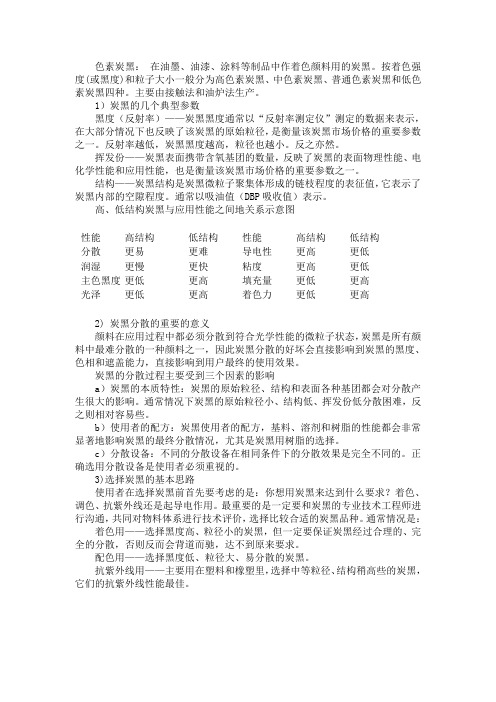
色素炭黑:在油墨、油漆、涂料等制品中作着色颜料用的炭黑。
按着色强度(或黑度)和粒子大小一般分为高色素炭黑、中色素炭黑、普通色素炭黑和低色素炭黑四种。
主要由接触法和油炉法生产。
1)炭黑的几个典型参数黑度(反射率)——炭黑黑度通常以“反射率测定仪”测定的数据来表示,在大部分情况下也反映了该炭黑的原始粒径,是衡量该炭黑市场价格的重要参数之一。
反射率越低,炭黑黑度越高,粒径也越小。
反之亦然。
挥发份——炭黑表面携带含氧基团的数量,反映了炭黑的表面物理性能、电化学性能和应用性能,也是衡量该炭黑市场价格的重要参数之一。
结构——炭黑结构是炭黑微粒子聚集体形成的链枝程度的表征值,它表示了炭黑内部的空隙程度。
通常以吸油值(DBP吸收值)表示。
高、低结构炭黑与应用性能之间地关系示意图性能高结构低结构性能高结构低结构分散更易更难导电性更高更低润湿更慢更快粘度更高更低主色黑度更低更高填充量更低更高光泽更低更高着色力更低更高2) 炭黑分散的重要的意义颜料在应用过程中都必须分散到符合光学性能的微粒子状态,炭黑是所有颜料中最难分散的一种颜料之一,因此炭黑分散的好坏会直接影响到炭黑的黑度、色相和遮盖能力,直接影响到用户最终的使用效果。
炭黑的分散过程主要受到三个因素的影响a)炭黑的本质特性:炭黑的原始粒径、结构和表面各种基团都会对分散产生很大的影响。
通常情况下炭黑的原始粒径小、结构低、挥发份低分散困难,反之则相对容易些。
b)使用者的配方:炭黑使用者的配方,基料、溶剂和树脂的性能都会非常显著地影响炭黑的最终分散情况,尤其是炭黑用树脂的选择。
c)分散设备:不同的分散设备在相同条件下的分散效果是完全不同的。
正确选用分散设备是使用者必须重视的。
3)选择炭黑的基本思路使用者在选择炭黑前首先要考虑的是:你想用炭黑来达到什么要求?着色、调色、抗紫外线还是起导电作用。
最重要的是一定要和炭黑的专业技术工程师进行沟通,共同对物料体系进行技术评价,选择比较合适的炭黑品种。
色素炭黑

颜料在应用过程中都必须分散到符合光学性能的微粒子状态,炭黑是所有颜料中最难分散的一种颜料之一,因此炭黑分散的好坏会直接影响到炭黑的黑度、色相和遮盖能力,直接影响到用户最终的使用效果。
炭黑的分散过程主要受到三个因素的影响
a)炭黑的本质特性:炭黑的原始粒径、结构和表面各种基团都会对分散产生很大的影响。通常情况下炭黑的原始粒径小、结构低、挥发份低分散困难,反之则相对容易些。
亲水性能好。由于我公司炭黑产品具有分散性能好,活性点分布在炭黑聚集体表面等特点,使得炭黑具有良好的亲水、亲油性能。使得最难分散的的炭黑变的想其他颜料一样容易分散。
加工性能良好。良好的分散性能,良好的亲水,亲油性能,再加上高纯度。使得炭黑的加工性能较一般炭黑好的多。
细度高8000目以上,打印机油墨,化纤抽丝等行业要求细度极高,杂质,硬碳等成分处理不够,会照成堵眼,断丝等现象,对加工照成严重后果。我公司炭黑经过过滤等,有效的清除了。
我公司色素炭黑特点:
基料选择上层。我公司生产的色素炭黑均采用国际大企业色素炭黑为基料,有效减少灰分,杂质,硬碳等非炭黑聚集体成分。从而大大提高色素炭黑的有效成分。更有效避免了以色素炭黑为着色产品的沉淀,反粗等现象。
活性高。我公司采用先进的处理工艺,使得炭黑的活性基可以分布到每个炭黑聚集体,有效提高了炭黑的加工性能和使用性能。
色素炭黑
色素炭黑 color black 在油墨、油漆、涂料等制品中作着色颜料用的炭黑。按着色强度(或黑度)和粒子大小一般分为高色素炭黑、中色素炭黑、普通色素炭黑和低色素炭黑四种。主要由接触法和油炉法生产。
1)炭黑的几个典型参数
黑度(反射率)——炭黑黑度通常以“反射率测定仪”测定的数据来表示,在大部分情况下也反映了该炭黑的原始粒径,是衡量该炭黑市场价格的重要参数之一。反射率越低,炭黑黑度越高,粒径也越小。反之亦然。
炭黑英文msds

﹡﹡﹡MATERIAL SAFETY DATA SHEET﹡﹡﹡1. IDENTIFICATION OF THE SUBSTANCE/PREPARATION AND THECOMPANY/UNDERTAKINGProduct Name: CARBON BLACK N330Synonyms: Carbon Black, Furnace BlackUse of the Substance/Preparation: Various, Industrial ProductsSupplier:Carbon Black Co. ,Ltd.City, ChinaTEL: FAX:02. HAZARDS IDENTIFICATIONIndication of danger: Hazardous according to the Worksafe Australia designated list of hazardous substances.Xn - Harmful.C3 - Carcinogen Category 3.Principle Routes of Exposure: Inhalation, Eye contact, Skin contactPOTENTIAL HEALTH EFFECTSEye Contact:May cause mechanical irritation. Irritating, but will not permanently injure eye tissue.Low hazard for usual industrial or commercial handling.Skin Contact:No adverse effects expected.Inhalation:Dust may be irritating to respiratory tract. Provide appropriate exhaust ventilation at machinery and at places where dust can be generated. See also Section 8.Ingestion:Health injuries are not known or expected under normal use. Low hazard for usual industrial or commercial handling.Carcinogenic Effects:Substance listed by IARC (International Agency for Research on Cancer). See also Section 9.Target Organ Effects:LungsMedical Conditions Aggravated by Exposure:Asthma, Respiratory disorder1Potential Environmental Effects:No special environmental precautions required. Not soluble in water. See also Section 12.4. FIRST AID MEASURESSkin Contact:Wash thoroughly with soap and water. Seek medical attention if symptoms develop.Eye Contact:Flush eyes immediately with large amounts of water for 15 minutes. Seek medical attention if symptoms develop.Inhalation:If cough, shortness of breath or other breathing problems occur, move to fresh air.Seek medical attention if symptoms persist. If necessary, restore normal breathing through standard first aid measures.Notes to Physician:Treat symptomatically.5. FIRE-FIGHTING MEASURESExtinguishing Media:Use foam, carbon dioxide (CO2), dry chemical or water spray. A fog is recommended if water is used. DO NOT USE a solid water stream as it may scatter and spread fire.Special Protective Equipment for Firefighters:Wear suitable protective equipment. In the event of fire, wear self-contained breathing apparatus.Specific Hazards:It may not be obvious that carbon black is burning unless the material is stirred and sparks are apparent. Carbon black that has been on fire should be observed closely for at least 48 hours to ensure no smoldering material is present. Burning produces irritant fumes. The product is insoluble and floats on water. If possible, try to contain floating material. This material creates a fire hazard because it floats on water.Hazardous Decomposition and/or Combustion Products:Carbon monoxide, Carbon dioxide, Oxides of sulphur, Organic products of decomposition.Risk of Dust Explosion:Do not create a dust cloud by using a brush or compressed air.26. HANDLING AND STORAGEHandling:Avoid contact with skin and eyes. Do not breathe dust. Provide appropriate exhaust ventilation at machinery and at places where dust can be generated. Do not create adust cloud by using a brush or compressed air. Fine dust is capable of penetratingelectrical equipment and may cause electrical shorts. Take precautionary measuresagainst static discharge.Storage:Keep in a dry, cool and well-ventilated place. Keep away from heat and sources of ignition. Do not store together with strong oxidizing agents. Do not store together with volatile chemicals as they may be adsorbed onto product. Keep in properly labeled containers.7. PHYSICAL AND CHEMICAL PROPERTIESAppearance: Black PelletsOdor: NonepH: 7-10(non-oxidized carbon black)Density: 1.7 - 1.9 g/cm³ @ 20°CBulk Density: 20 - 550 kg/m3Specific Gravity: Not determinedBoiling Point/Range: Not applicableMelting Point/Range: Not applicableVapor Pressure: Not determinedWater Solubility: Soluble% Volatile (by Weight): < 2.5% @ 950°C (non-oxidized carbon black)Evaporation Rate: Not applicableViscosity: Not determinedPartition Coefficient (n-octanol/water): Not determinedFlash Point: Not applicableMethod: Not applicableExplosion Limits in Air - Upper (%): Not determinedExplosion Limits in Air - Lower (%): 50 g/m3 (dust)Autoignition Temperature: > 140°C (transport)3Method: IMDG-CodeMinimum Ignition Temperature: > 350°C (BAM Furnace)Burn Velocity: > 45 seconds(Not cl assifiable as "Highly Flammable” or "Easily Ignitable") Flammability Classification: Not applicable8. STABILITY AND REACTIVITYStability: Stable.Reactivity: May react exothermically upon contact with strong oxidizersIncompatible Materials: Strong oxidizers such as chlorates, bromates, and nitrates.Hazardous Polymerization: Hazardous polymerization does not occur.Mechanical Sensitivity (shock): Not sensitive to mechanical impact.Conditions to Avoid: Do not expose to temperatures above 300°C. Keep away from oxidizing agents in order to avoid exothermic reactions.Hazardous Decomposition and/or Combustion Products:Carbon monoxide, Carbon dioxide, Oxides of sulphur, Organic products ofdecomposition.Static Discharge Effects: Take precautionary measures against static discharges. Avoid dust formation. All metal parts of the mixing and processing equipment must be earthed/grounded. Ensure all equipment is electrically earthed/grounded before beginning transfer operations.9. TOXICOLOGICAL INFORMATIONACUTE TOXICITYOral LD50: LD50/oral/rat = > 8000 mg/kg.Eye Irritation: Rabbit. Draize score 10-17/110 @ 24 hr. Non-irritating.Skin Irritation: Rabbit. 0.6/8. Slight irritation.SUBCHRONIC TOXICITYRat, inhalation, duration 90 daysNOAEL = 1.0 mg/m3Target organ: lungsEffect: inflammation, hyperplasia, fibrosis.CHRONIC TOXICITYRat, oral, duration: 2 yearsEffect: no tumorsMouse, oral, duration: 2 years4Effect: no tumorsMouse, dermal, duration: 18 monthsEffect: no skin tumorsRat, inhalation, duration: 2 yearsTarget organ: lungsEffect: inflammation, fibrosis, tumorsNote: Tumors in the rat lung are related to the fine particle overload phenomenon rather than to a specific chemical effect of the dust particles in the lung. These effects in rats have been reported in studies on other inorganic insoluble particles and appear to be species specific. Tumors have not been observed in other species (i.e., mouse and hamster) for other insoluble particles under similar circumstances and study conditions.Carcinogenic Effects: Substance listed by IARC (International Agency for Research on Cancer). Does not contain any substances listed by NTP (National Toxicology Program), OSHA (Occupational Safety and Health Administration), ACGIH (American Conference for Governmental Industrial Hygienists) or EU (European Union).Carbon Black IARC Statement: In 1995 International Agency for Research on Cancer (IARC) concluded, "There is inadequate evidence in humans for the carcinogenicity of carbon black." Based on rat inhalation studies, IARC concluded that there is "sufficient evidence in experimental animals for the carcinogenicity of carbon black", resulting in their classifying carbon black as "possibly carcinogenic to humans (Group 2B)".Carbon black is not designated a carcinogen by the U.S. National Toxicology Program (NTP), the U.S. Occupational Safety and Health Administration (OSHA), the American Conference of Governmental Industrial Hygienists (ACGIH) or the European Union (EU).The U.S. National Institute of Occupational Safety and Health (NIOSH) 1978 criteria document on carbon black recommends that only carbon blacks with polycyclic aromatic hydrocarbon (PAH) levels greater than 0.1% require the measurement of PAHs in air. As some PAHs are possible human carcinogens, NIOSH recommends an exposure limit of 0.1 mg/m3 for PAHs in air, measured as the cyclohexane-extractable fraction.Epidemiology: Results of epidemiological studies of carbon black production workers suggest that cumulative exposure to carbon black may result in small decrements in lung function, as measured by FEV1. In addition to normal age related decline in the FEV1 of approximately 1200 ml over 40 years, according to a European investigation, exposure to 1 mg/m3 (inhalable fraction) of carbon black over a 40-year lifetime will result in an additional 48 milliliter (ml) decline in FEV1. Asimilar morbidity study in the United States suggested a 27 ml decline in FEV1 from a 1mg/m3 exposure over a 40-year period. The relationship between symptoms and exposure to carbon black is less clear. In the U.S. study, 9% of the highest exposure group (in contrast to 5% of the unexposed group) reported symptoms consistent with chronic bronchitis. In the European study, methodological limitations in the administration of the questionnaire limit the drawing of definitive conclusions about symptoms. This study, however, indicated a link between carbon black and small opacities on the chest films, with negligible effects on lung function. A study of carbon black workers in the UK showed an elevated incidence of lung cancer but it was not considered to be related to carbon black exposure. A study of workers at a large German carbon black manufacturing facility found increased lung cancer mortality among German carbon black workers, but found no apparent dose-response relationship between lung cancer mortality and several indicators of occupational exposure, including years of employment and carbon black exposure. The study concluded that the high lung cancer mortality could not be fully explained by selection, smoking, or other occupational risk factors, but the results also provided little evidence for an effect from carbon black exposure. A recent mortality study of US carbon black workers found no association between employment in carbon black production and lung cancer or any other type of cancer.Mutagenic Effects: A dimethylsulfoxide (DMSO) suspension of carbon black produced negative results in an Ames test. Organic solvent extracts of carbon black, however, can contain traces of5polycylic aromatic hydrocarbons (PAH), which may affect the results in different in-vitro test systems. In an experimental investigation, mutational changes in the hprtgene were reported in alveolar epithelial cells in the rat following inhalation exposure to carbon black. This observation is believed to be rat specific and a consequence of "lung overload" (see Chronic Toxicity above).Reproductive Toxicity: Did not show effects in animal experiments.Sensitizing Effects: Contains no known sensitizers.Synergistic Materials: None reasonably foreseeable.10. ECOLOGICAL INFORMATIONAquatic Toxicity:Fish (Brachydanio rerio): LC50 (96hr) > 1,000 mg/L. (Method: OECD 203).Daphnia magna: EC50 (24hr) > 5,600 mg/L. (Method: OECD 202).Algae (Scenedesmus subspicatus): EC50 (72hr) > 10,000 mg/L.Algae (Scenedesmus subspicatus): NOEC >= 10,000 mg/L.Activated sludge: EC0 (3hr) >= 800 mg/L. (Method: DEV L3 TTC test).ENVIRONMENTAL FATEMobility: Not expected to migrate. Insoluble.Bioaccumulation: Not expected due to physicochemical properties of the substance.Persistence / Degradability: Not expected to degrade.Distribution to Environmental Compartments: Insoluble. Expected to remain on soil surface.11. DISPOSAL CONSIDERATIONSProduct, as supplied, should be disposed of in accordance with the regulations issued by the appropriate federal, state and local authorities. Same consideration should be given to containers and packaging.12. TRANSPORT INFORMATIONThe following organizations do not classify carbon black as a "hazardous cargo" if it is "carbon,non-activated, mineralorigin". Cabot carbon blacks meets this definition.- Canadian Transport of Dangerous Goods Regulation- European Transport of Dangerous Goods Regulation- GGVS, GGVE, RID, ADR, IMDG Code, ICAO-TI- United Nations (no UN number)- US Department of TransportationCAS NO 1333-86-4UN Number: 1361UN Proper Shipping Name: Not classifiedUN Shipping Class: Not classified6UN Packing Group: Not classifiedInternational TransportationIdentification:"Carbon black, non-activated, mineral origin".Not dangerous according to IMDG-Code.Not dangerous according to ICAO-TI.US Rail Regulations: Not classified13. ACCIDENTAL RELEASE MEASURESPersonal Precautions: CAUTION: Wet carbon black produces slippery walking surfaces. Avoid dust formation. Ensure adequate ventilation. Use personal protective equipment. See alsoSection 8.Methods for Cleaning Up: Clean up promptly by vacuum. Use of a vacuum with high efficiency particulate air(HEPA) filtration is recommended. Do not create a dust cloud by using a brush orcompressed air. Pick up and transfer to properly labelled containers. See Section 13.Environmental Precautions: Do not allow material to contaminate ground water system. The product is insolubleand floats on water. If possible, try to contain floating material. Local authoritiesshould be advised if significant spillages cannot be contained.14. EXPOSURE CONTROLS / PERSONAL PROTECTIONEXPOSURE LIMITSThe table below is a summary. Please see the specific legislation for complete information.Carbon Black, CAS RN 1333-86-4: Australia: 3.0 mg/m3, TWABelgium - OEL: 3.6 mg/m3, TWACanada: 3.5 mg/m3, TWAChina: 4.0 mg/m3, TWA8.0 mg/m3, STELFinland: 3.5 mg/m3, TWA7.0 mg/m3, STELFrance - INRS: 3.5 mg/m3, TWA/VMEGermany - TRGS 900: 3.0 mg/m3, respirable TWA10.0 mg/m3, inhalable TWAGermany - MAKs: 1.5 mg/m3, respirable TWA4.0 mg/m3, inhalable TWAIreland: 3.5 mg/m3, TWA7.0 mg/m3, STELItaly - OEL: 3.5 mg/m3, TWAKorea: 3.5 mg/m3, TWANetherlands - MAC: 3.5 mg/m3, TWA7Norway: 3.5 mg/m3, TWASpain: 3.5 mg/m3, TWASweden - TLV: 3.0 mg/m3, TWAUnited Kingdom - WEL: 3.5 mg/m3, inhalable TWA (a)7.0 mg/m3, inhalable STELUS ACGIH - TLV: 3.5 mg/m3, TWAUS OSHA - PEL: 3.5 mg/m3, TWANote: Unless otherwise indicated as "respirable" or "inhalable", the exposure limitrepresents a "total" value. The inhalable exposure limit has been demonstrated to bemore restrictive than the total exposure limit, by a factor of approximately 3.15. STABILITY AND REACTIVITYStability: Stable.Reactivity: May react exothermically upon contact with strong oxidizers.Cabot Corporation___________________________________________________________________ ______Product Name: REGAL 250R Product Code: R250R Revision Date: 18/June/2007 Page 6 of 10 Incompatible Materials: Strong oxidizers such as chlorates, bromates, and nitrates.Hazardous Polymerization: Hazardous polymerization does not occur.Mechanical Sensitivity (shock): Not sensitive to mechanical impact.Conditions to Avoid: Do not expose to temperatures above 300°C. Keep away from oxidizing agents inorder to avoid exothermic reactions.Hazardous Decomposition and/orCombustion Products:Carbon monoxide, Carbon dioxide, Oxides of sulphur, Organic products ofdecomposition.Static Discharge Effects: Take precautionary measures against static discharges. Avoid dust formation. Allmetal parts of the mixing and processing equipment must be earthed/grounded.Ensure all equipment is electrically earthed/grounded before beginning transferoperations.16. OTHER INFORMATIONCarbon Black Extracts:Manufactured carbon blacks generally contain less than 0.1% of solvent extractable polycyclic aromatic hydrocarbons(PAH). Solvent extractable PAH content depends on numerous factors including, but not limited to, the manufacturingprocess, desired product specifications, and the analytical procedure used to measure and identify solvent extractable8materials. Questions concerning PAH content of carbon black and analytical procedures should be addressed to yourcarbon black supplier.General Information:The carbon black industry continues to sponsor research designed to identify adverse health effects from long termexposure to carbon black. This MSDS will be updated as new safety and health information may become available.9。
炭黑MSDS通用安全技术说明书

化学品安全技术说明书1、企业资质认证产品名称:N炭黑别名:炭黑,炉法炭黑材料应用:各种工业产品供应商:炭黑有限公司地址:中国68号联系电话: 666 传真: 8882、炭黑的组成成分3、危险性概述危害显示:本品为非危险物品主要接触途径:吸入,眼睛接触,皮肤接触。
潜在的健康影响:眼睛接触:可能引起机械刺激。
但是不会永久的伤害眼膜。
对于平常的工业或商业接触有较低的危害。
皮肤接触:无已知的不良反应。
吸入:粉尘可能刺激呼吸道。
应对机器设备和能够产生灰尘的地方提供适当的排气通风。
另请参阅第8部分。
食入:正常使用下不会出现已知的健康损伤。
对于平常的工业或商业接触只有较低的危害。
致癌影响:国际癌症研究机构列出的物品。
另请参阅第9部分。
主要影响器官:肺。
暴露恶化的疾病:哮喘,呼吸障碍潜在的环境影响:不需要特别的环境预防措施。
不溶解于水。
另请参阅第12部分。
4、急救措施皮肤接触:应用肥皂和水彻底清洗。
若症状加重,请就医。
眼睛接触:应立即用大量的水冲洗眼睛15分钟。
若症状加重,请就医。
吸入:如果咳嗽,呼吸急促或者发生其他呼吸问题,请移到其他地方呼吸新鲜空气。
若症状无好转,请就医。
如果有必要的话,请通过标准的急救措施来恢复正常呼吸。
食入:不要催吐,如清醒,给予几杯水,千万不要给休克的人通过口腔喂任何东西。
医生提示:请根据症状处理。
5、消防措施灭火器:应使用泡沫,二氧化碳,干粉或者水喷雾。
如果已经使用过水,推荐使用水雾。
不要使用强直流水,因为它可能溅射扩散火苗。
消防员的特殊防护装备:要穿戴合适的防护装备。
发生火灾时,应佩带独立的呼吸设备。
具体危害:炭黑燃烧时可能不明显,除非搅拌时出现火花。
对已经着火的炭黑,我们应该严密地观察至少48小时以确保无隐燃存在。
燃烧会产生刺激性的烟气。
该产品不能溶解的,并且漂浮在水上。
如果可能,设法控制悬浮物质。
该物质会产生火灾隐患,因为它漂浮在水上。
分解或燃烧产生的危害物:一氧化碳,二氧化碳,硫的氧化物,分解的有机产物。
Pigmentcarbonblack(色素炭黑)
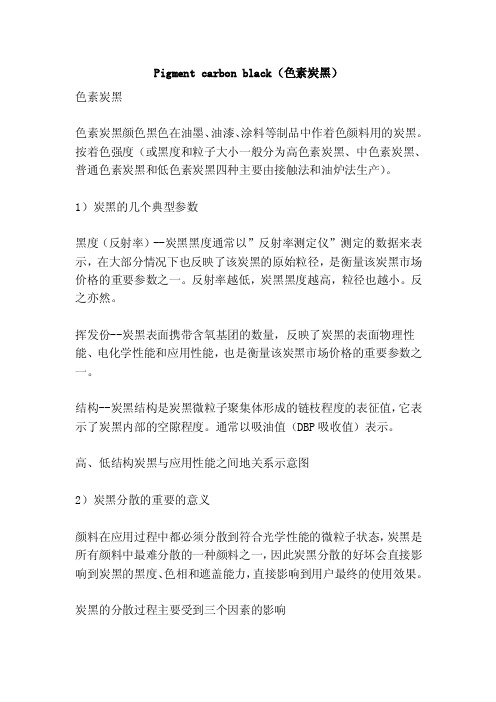
Pigment carbon black(色素炭黑)色素炭黑色素炭黑颜色黑色在油墨、油漆、涂料等制品中作着色颜料用的炭黑。
按着色强度(或黑度和粒子大小一般分为高色素炭黑、中色素炭黑、普通色素炭黑和低色素炭黑四种主要由接触法和油炉法生产)。
1)炭黑的几个典型参数黑度(反射率)--炭黑黑度通常以”反射率测定仪”测定的数据来表示,在大部分情况下也反映了该炭黑的原始粒径,是衡量该炭黑市场价格的重要参数之一。
反射率越低,炭黑黑度越高,粒径也越小。
反之亦然。
挥发份--炭黑表面携带含氧基团的数量,反映了炭黑的表面物理性能、电化学性能和应用性能,也是衡量该炭黑市场价格的重要参数之一。
结构--炭黑结构是炭黑微粒子聚集体形成的链枝程度的表征值,它表示了炭黑内部的空隙程度。
通常以吸油值(DBP吸收值)表示。
高、低结构炭黑与应用性能之间地关系示意图2)炭黑分散的重要的意义颜料在应用过程中都必须分散到符合光学性能的微粒子状态,炭黑是所有颜料中最难分散的一种颜料之一,因此炭黑分散的好坏会直接影响到炭黑的黑度、色相和遮盖能力,直接影响到用户最终的使用效果。
炭黑的分散过程主要受到三个因素的影响一)炭黑的本质特性:炭黑的原始粒径、结构和表面各种基团都会对分散产生很大的影响通常情况下炭黑的原始粒径小、结构低、挥发份低分散困难,反之则相对容易些。
b)使用者的配方:炭黑使用者的配方,基料、溶剂和树脂的性能都会非常显著地影响炭黑的最终分散情况,尤其是炭黑用树脂的选择。
C)分散设备:不同的分散设备在相同条件下的分散效果是完全不同的。
正确选用分散设备是使用者必须重视的。
3)选择炭黑的基本思路使用者在选择炭黑前首先要考虑的是:你想用炭黑来达到什么要求?着色、调色、抗紫外线还是起导电作用。
最重要的是一定要和炭黑的专业技术工程师进行沟通,共同对物料体系进行技术评价,选择比较合适的炭黑品种。
通常情况是:着色用--选择黑度高、粒径小的炭黑,但一定要保证炭黑经过合理的、完全的分散,否则反而会背道而驰,达不到原来要求。
- 1、下载文档前请自行甄别文档内容的完整性,平台不提供额外的编辑、内容补充、找答案等附加服务。
- 2、"仅部分预览"的文档,不可在线预览部分如存在完整性等问题,可反馈申请退款(可完整预览的文档不适用该条件!)。
- 3、如文档侵犯您的权益,请联系客服反馈,我们会尽快为您处理(人工客服工作时间:9:00-18:30)。
色素炭黑说明书MSD S
作者:
日期:
色素炭黑的安全技术说明书(MS D S)
第一部分:化学品名称和公司
中文名称1:色素炭黑
英文名称1: color P igm e n t c ar b on
C AS No . :1 3 33—86-4
分子式:C分子量:1 2
第二部分:成分/组成信息
主要成分:
碳(C)元素含量(Wt% >93% 含氧基团含量(Wt%)<7%。
有害物成分:
多环芳烃(P AH)(C A S No.?)含量(W%)<0.001%
砷(As)(CAS No. 7 44 0-38-2 )含量(Wt%)<0.0 0 0 1% 镉(Cd)(CA S No. 7440-43-9 )含量(Wt% <0. 00001 % 汞(H g )(C A S No .743 9 -97-6 )含量(Wt %)<0.0001% 铅(Pb)( C AS No.74 3 9-92 —1 )含量(W t %)<0.0001% 铬(Cr)( C AS No .7 4 4 0—47—3)含量(Wt%)<0.001% 第三部分:危险性概述
危险性类别:未列入
侵入途径:呼吸道吸入、眼睛、皮肤
健康危害:
长期大量地由呼吸道吸入炭黑粉尘,可能最终造成对肺部的损伤。
目前,没有明确的医学报道证明炭黑会引起癌变的结果。
但可以列入如人类的可能致癌的物质。
对眼睛的损伤主要症状是异物刺激感、流泪。
对皮肤主要是皮肤的弄脏和刺激
环境危害:
炭黑的外泄暴露,除了会弄脏周围环境外没有发现会对环境造成严重的影响或损害。
燃爆危险:
在本品工作场所若形成纯炭黑的粉尘环境,可能造成粉尘爆炸。
本品不是易燃物,一般不会被点燃,若较长时间地处于30or 以上则可能会无明火地缓慢燃烧,同时释出一氧化碳、二氧化碳或极少量的含氮、硫氧化物。
第四部分:急救措施
安全介绍:
吸入:1.立即将被污染的患者转移到有大量新鲜空气的场所。
眼睛接触:1.立即撑开患者被污染眼睛的眼皮用缓和流动的温水冲洗至少5分钟以上。
2.用医用?金霉素?眼药膏涂抹患者眼睛。
皮肤接触:1 .及时用大量水及温和性肥皂缓和但彻底的清洗。
食入:1. 若有误食应立即让患者彻底漱口。
2.让患者喝下24 0 -3 0 0毫升的水。
最重要症状及危害效应:高浓度粉尘可能造成不适,若浓度更高可能引起呼吸困难及疲倦。
第五部分消防措施
危险特性:本品不是易燃物,一般不会被点燃,若较长时间地处于300 C以上会无明火地缓慢燃烧。
有害燃烧产物:燃烧同时释出一氧化碳、二氧化碳或极少量的含氮、硫氧化物。
适用灭火剂:喷水、砂土、二氧化碳灭火器、泡沫灭火器、干粉灭火器等。
灭火时可能遭遇之特殊危害:
若为纯炭黑粉末,可能造成粉尘爆炸。
燃烧缓慢,火场会释放出一氧化碳、二氧化碳。
在火场中也可能释出氮氧化物及硫氧化物。
特殊灭火程序:
1•炭黑储区火灾时,建议采用二氧化碳灭火器。
2.尽可能在最远的距离,大量使用水雾、喷洒,冷却灾区的容器外侧。
3 .可能形成较高浓度的一氧化碳、二氧化碳,故须戴空气呼吸器(自携式呼吸防护具SCBA或供气式呼吸防护具以保护呼吸系统。
第六部分:泄漏应急处理
清理方法:
1.不要碰触外泄物。
2.避免外泄物进入下水道或密闭的空间内。
3.在安全许可的情况下,设法阻止或减少泄漏。
4.少量泄漏时:用装有高效率过滤器之真空吸抽外泄物,或用肥皂水或抑制粉尘的产品将炭黑弄湿,再铲入干燥且有盖的容器中,标示处置。
5.大量溢漏时:连络消防、紧急处理单位及供货商以寻求协助。
第七部分:操作处置与储存
操作注意事项:
1 .生产过程密闭化,使用防尘容器并避免粉尘累积,系统采用一定的负压以免粉尘外泄。
2.操作人员必须经过专门培训,严格遵守操作规程。
3.操作人员进入炭黑贮存区应视同进入密闭区域一般,遵循必须的步骤。
因为炭黑区可能有一氧化碳毒气,氧浓度也可能太低。
操作人员应佩戴自吸过滤式防尘口罩,戴化学安全防护眼镜,戴乳胶手套。
避免粉尘污染。
4.炭黑容器须加标示,不用时要保持密闭。
5.避免空容器残留物造成的危害。
储存注意事项:
1.贮存在阴凉、干燥且通风良好的库房。
远离火种、热源。
防止阳光直射。
2.远离不相容物贮存。
应防止产品的包装及贮存容器损坏。
3.贮区应用合适的构材并经常清扫以免累积粉尘。
4.应与强氧化剂分开存放,切忌混储。
5.贮储区应备有合适的材料收容泄漏物。
6.贮存区附近应有适当的灭火剂。
第八部分:接触控制/个体防护
工程控制:
1.采用一般稀释或局部排气装置。
2.必要时应使用局部排气系统及制程密闭来控制空气中的粉尘浓度。
3.在室外或法规允许的位置装置集尘器。
4.及时提供充分而新鲜的空气以补充排气系统抽出的空气。
控制参数:
个人防护设备:
呼吸防护:
1.17. 5 m g/m 3以下:粉尘及雾滴的呼吸防护具。
2. 35 m g /m3以下:粉尘及雾滴的呼吸防护具,仍可弃式及1/4面罩 除外;或供气式呼吸防护具。
3 . 8 7.5 mg / m3以下:含粉尘及雾滴的动力型空气净化式呼吸防护 具;或定流量式供气式呼吸防护具。
4. 17 5 mg /m3以下:含高效率粒子滤器之全面型呼吸防护具;或含
高效率粒子滤器及紧密式面罩之动力型空气净化式呼吸防护具
; 或全面型空气呼吸器
式呼吸防护具。
5. 1 7 5 0 mg/ m 3 6. 未知浓度或IDLH 防护具SC B A );或正压
式全面型供气式呼吸防护具与辅助型正 压式空气呼吸器(自携式呼吸防护具S CBA 一起使用。
7. 逃生:含高效能粒子滤器的全面型呼吸防护具;或逃生型空气呼 吸器(自携式呼吸防护具SC B A )。
手部防护:防尘手套
眼睛防护:1 .化学安全护目镜。
2.面罩。
皮肤及身体防护:1.连身工作服。
2.
工作鞋。
卫生措施: 1. 工作后尽速脱掉污染之衣物,洗净后才可再穿戴或丢弃,若洗涤 须告知洗衣人员污染物之危害性。
2. 工作场所严禁抽烟或饮食。
3. 处理此物后,须彻底洗手。
4. 维持作业场所清洁。
第九部分:理化特性
物质外观:粉末或圆球
颜色:黑色
水溶解度:不溶于水
p H 值:2-10
大量密度:(2 0C 时,水=1) 0 .1- 0. 5
分解温度:(r .). >30 0
主要用途:
黑色的着色、调色颜料,也可应用于塑料上的抗紫外作用,应用 于涂料、印刷油墨、塑料、皮革化工、造纸和其它行业。
第十部分:稳定性和反应活性 稳定性:在正常状况下是稳定的。
应避免之状况:高温、明火、火花。
应避免之物质:强氧化剂。
如氯酸盐、溴酸盐、硝酸盐等。
聚合危害:无 分解产物: 第十一部分:毒理学资料 急毒性:
(自携式呼吸防护具SCBA ;或全面型供气
以下:正压式供气式呼吸防护具。
情况:正压式全面型空气呼吸器(自携式呼吸 氧化碳、 二氧化碳或极少量的含氮、硫氧化物。
吸入:
1.炭黑粒子极细,可能吸入肺部深处,但没有资料显示会引起中毒。
2.吸入较高浓度炭黑粉尘可能引起不适感,引起咳嗽及轻微的刺激感,若浓度更高可能引起呼吸困难及疲倦感。
皮肤接触:
1.炭黑不会造成对皮肤的刺激,但若用粗硬的方式洗清炭黑粉尘则会刺激皮肤。
2.炭黑虽不会被皮肤吸收,但其粒子可能存积在皮肤内的毛囊中。
眼睛接触:可能会引起异物感,会引起流泪、眨眼及短暂性疼痛。
局部效应:无
致敏感性:无
慢毒性或长期毒性:通常吸入而累积在肺部的炭黑粉尘,可被肺逐渐排除。
但若浓度过高,则会损伤肺肠,造成肺功能降低或肺气肿,甚至可能因增加心脏负荷而引发心脏疾患。
特殊效应:IARC将炭黑列为G roup 2B级:可能人体致癌。
ACQ H将之列为A4级:无法判断为人体致癌性。
急性毒性:L D 50:无资料
LC50:(测试动物、暴露途径):2 700 0 mg/m3/1H。
第十二部分:生态学资料
生态毒理毒性:无生物降解性:无非生物降解性:无生物富集或生物积累性:无其它有害作用:无第十三部分:废弃处置废弃物性质:炭黑和包装袋以及可能的相关容器。
废弃处置方法:用焚烧和安全掩埋法处置,也可考虑洗涤回收利用。
废弃注意事项:依照当地的《废弃物处理法规法》处理。
